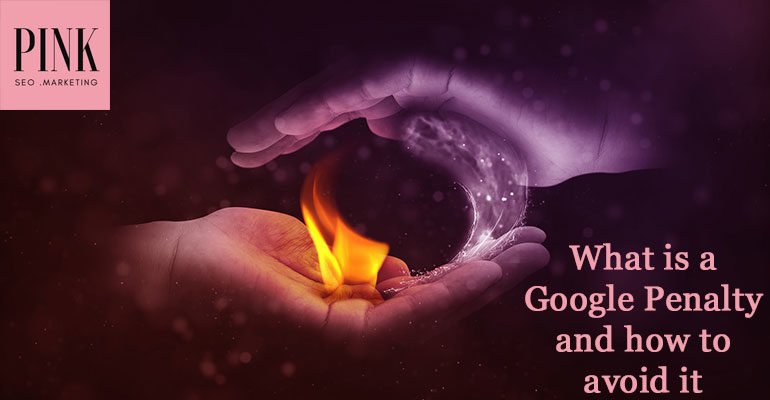What is a Google Penalty and how to avoid it
- Home
- Articles and Publications
- SEO Tips
- What is a Google Penalty and how to avoid it
What is a Google Penalty and how to avoid it
Posted on March 20, 2018
0 Comment
Aiming to provide the best results to its users, Google needs to try and get rid of the ones it considers as bad ones, penalising those sites. A Google Penalty is an action made as a consequence of breaking the rules it enforces. It may be the result of a manual action or an update to the algorithm. In this article, we will see all of these cases, and how to deal with them.
Is it a Google Penalty or an algorithmic change?
Google can be such a vital source of business opportunities for our websites, that we really cannot afford to ignore the rules behind it. Knowing them will help us avoid to be hit by any Google penalty, but can also give a big advantage in ranking our site better than others who don’t.
Some of the themes may seem very technical, but we will do our best to explain them in the easiest way, as always. For about 15 years, Google has been refining its algorithm. Every year, its changes happen around 500–600 times. Most of these are minor changes, but some of the major ones are truly part of the history of SEO. Here‘s the history of its changes.
The most famous major updates that can lead to a Google Penalty are:
- Panda (2011). This update has been the first of a series of earthquakes for website owners. It hit sites hard, affecting up to 12% of search results (a number that came directly from Google). Panda targeted thin content, content farms, sites with high ad-to-content ratios, and a number of other quality issues. Panda rolled out over some months, hitting Europe in April 2011.
- Penguin (2012) The Penguin update aimed to combat genuine spam rather than sites that were legitimate but poorly made. Penalties focused on keyword stuffing, cloaking, link building … basically, any method you’ve heard of referred to as “black hat” SEO tactics”.
- Hummingbird (2013). The result of this algorithm update was a powerful change to semantic search and the Knowledge Graph.
- Pigeon (2014). This update had a very big impact on local results.
- Secure Update (2014). Google announced that they would be giving preference to secure sites and that adding encryption would provide a rankings boost. This started out small, but close to 75% of page-1 Google organic results were secure/HTTPs by the end of 2017. Effective July 2018, Google’s Chrome browser will mark non-HTTPS sites as ‘not secure’.
- Mobile Update, aka Mobilegeddon (2015). With this update, ranking preference was given to websites that are “responsive” in design — or scalable to mobile devices.
- Intrusive Interstitial Penalty (January 2017). This update punishes websites with pop-out contents that hinder a page’s functionality on a mobile device.
- Google Jobs (June 2017). Google’s jobs portal drew data from almost all of the major providers, including LinkedIn, Monster, Glassdoor, and CareerBuilder. This update had an impact on some of the job boards.
- Snippet Length Increase (November 2017). The new Meta Description limit almost doubled up to 300 characters from the previous 155.
These updates are not one-offs. They are valid and reinforced year after year to keep up with the rules and to make sure Google users will remain always more and more satisfied with their results.
What is a Google Penalty as a result of a manual action?
Further to the algorithmic updates, there also are hundreds of thousands of manual actions that Google takes every year.
When it happens, you will receive the worst message you would ever want to receive as a webmaster or SEO. You will be notified on your Google Search Console that a manual action that has been placed on your website.
The main reasons for manual actions are:
- Unnatural Links to Your Site
- Hacked Site
- Thin Content
- Pure Spam
- User-Generated Spam
- Cloaking and Sneaky Redirects
- Hidden Text and Keyword Stuffing
- Spammy Freehosts
- Spammy Structured Markup
How to determine if your site is affected by a Google Penalty.
As weird as it may seem, although many websites get punished for “black hat” SEO tactics, most marketers or webmasters do not notice when they have. According to Kissmetrics, only 5% of penalized websites submit a reconsideration request every month to recover their rankings.
If you’re familiar with your Google Webmaster Tools/Search Console and you check it frequently enough, you will never lose any manual action notification.
People generally get worried when the business opportunities driven by their websites drop dramatically and for a long time. In this case, they might get to check their Google Analytics. If they spot a sudden drop in organic traffic, they might ask an SEO Specialist to inspect.
Here’s a little checklist to try and understand if you might have a Google penalty on your website:
- Many intrusive pop-out ads.
- Keyword-stuffed content.
- Low HTML to text ration (meaning often short content), or unedited for quality and errors.
- Spammy/sketchy backlink profile
- Low quality (gambling, adult, et similia) /bought backlinks
- Hidden (“cloaked”) keywords on your page that users can’t see
- Missing legitimate security certificate (HTTPS).
- Copied/plagiarism/ boilerplate content from other websites without permission.
- Excessively high load time
- Poor appearance on mobile devices.
This Google penalty checker can show you which of the major Google penalties hit you and eventually when. If you suspect you might be affected by minimal ones, an SEO Specialist can perform a full Site Audit, track your positions in SERPs, your backlinks and content.
Also, try and acquire knowledge as much as you can: it is the best way to avoid a Google penalty in the first place.
A Google penalty, in fact, can be caused
- By a lack of knowledge
- Or by the purposeful violation of rules and use of black-hat techniques
In conclusion, to avoid a Google penalty:
- Run frequently check SEO audits
- Remove or disavow unnatural or spammy links manually
- Pay attention to your anchor texts
- Avoid any duplicate content.
- Create high-quality content with no keyword stuffing
- Basically, make sure that your website is up-to-date, helpful, and trustworthy.
Let us know in the comments or social networks if you ever suspected you might have been affected by a Google penalty and if you’d like some assistance, do not hesitate to contact us for an assessment!


